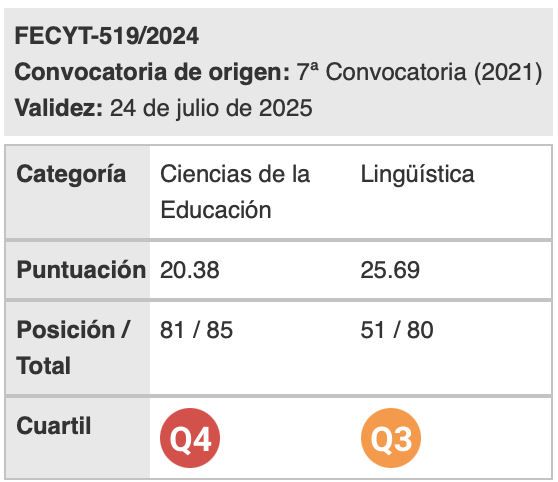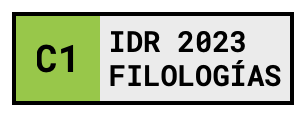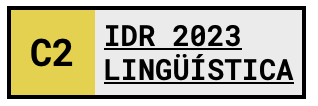Exploring acknowledgement practices in English-medium astrophysics research papers: Implications on authorship
Palabras clave:
astrophysics, research papers, acknowledgements, authorshipResumen
This article reports the findings of a diachronic study of acknowledgement practices in 300 randomly collected research papers published during three different periods (1998, 2004 and 2012) in the most prestigious American and European astrophysics journals written in English. In order to investigate the influence of these practices on authorship patterns, we analyzed the distribution over time of a series of quantitative variables (number, length and types of acknowledgements, mean number of words/number of acknowledgements per research paper and mean number of acknowledgements/number of authors per research paper, number of named and unnamed acknowledgees, number of identified and anonymous referees, and number of emotionally charged-words). Comparisons between periods were carried out and Student’s t-tests were applied to the quantitative results. Our main findings show that acknowledgements are very common in astrophysics since they are present in 96% of the whole corpus. Financial, mainly public, and instrumental supports are the most frequently acknowledged categories. The number and length of acknowledgements and the mean number of words/number of acknowledgements per research paper grow over time. Financial, instrumental and conceptual assistance, unnamed individuals and anonymous referees increase over time, whereas moral, editorial and unclassified supports, named individuals and identified referees, and emotionally-charged words decline. If we focus on each journal publication context, we can observe that the research papers published in the American journals include more and longer acknowledgements, with a higher mean number of acknowledgements per author, more financial and instrumental supports, and a lower percentage of emotionally-charged words, whereas the European journals contain more conceptual and editorial supports. All these data can be understood in the frame of growing scientific professionalism, while a detailed cross-journal analysis may occasionally suggest honorary/guest/gift authorship.Descargas
Citas
Bazerman, C. (1994). Constructing experience. Carbondale, IL: Southern Illinois University Press.
Bazerman, C. (2000). Shaping written knowledge: The Genre and activity of the experimental article in science. WAC Clearinghouse Landmark Publications in Writing Studies. <http://wac.colostate.edu/books/ bazerman_shaping> [16/07/2015].
Beer, J. J., & Lewis, W. D. (1963). Aspects of the professionalization of Science. Daedalus, 92(4), 764-784.
Butler Burton, W. (2007). Some statistics regarding the astrophysical Journal as published between 1990 and 2006, including comparisons with sister journals. In A. Heck & L. Houziaux (Eds.), Future professional communication in astronomy (31-59). Bruxelles: Mémoires de l’Académie Royale de Belgique.
Claxton, L. D. (2005). Scientific authorship. Part 2. History, recurring issues, practices and guidelines. Mutation Research, 589, 31-45. doi:10.1016/j.mrrev.2004.07.002.
Connor, U. (2004). Intercultural rhetoric research: Beyond texts. Journal of English for Academic Purposes. Special Issue on Contrastive Rhetoric in EAP, 3(4), 291-305. doi:10.1016/j.jeap.2004.07.003.
Costas, R., & van Leeuwen, T. N. (2012). Approaching the ‘Reward Triangle’: General analysis of the presence of funding acknowledgments and ‘peer interactive communication’ in scientific publications. Journal of the Association for Information Science and Technology, 63(8), 1647-1661. doi: 10.1002/asi.22692.
Cronin, B. (1995). The Scholar's Courtesy. The Role of acknowledgments in the primary communication process. London: Taylor Graham.
Cronin, B., & Weaver, S. (1995). The praxis of acknowledgment: From bibliometrics to influmetrics. Revista Española de Documentación Científica, 18(2), 172-177. doi:10.3989/redc.1995.v18.i2.654.
Cronin, B., & Franks, S. (2006). Trading cultures: Resources mobilization and service rendering in the life sciences as revealed in the journal articles’ paratext. Journal of the American Society for Information Science and Technology, 57(14), 1909-1918.
Cronin, B., McKenzie, G., & Rubio, L. (1993). The norms of acknowledgments in four humanities and social sciences disciplines. Journal of Documentation, 49(1), 29-43.
Cronin, B., Shaw, D., & La Barre, K. (2003). A cast of thousands: Coauthorship and subauthorship collaboration in the 20th century as manifested in the scholarly literature of Psychology and Philosophy. Journal of the American Society for Information Science and Technology, 54(9), 855-871. doi: 10.1002/asi.10278.
Cronin, B., Shaw, D., & La Barre, K. (2004). Visible, less visible, and invisible work: Patterns of collaboration in 20th century chemistry. Journal of the American Society for Information Science and Technology, 55(2), 160-168. doi:10.1002/asi.10353.
Curry, M. J., & Lillis, T. (2004). Multilingual scholars and the imperative to publish in English: Negotiating interests, demands and rewards. TESOL Quarterly, 38(4), 663-688. doi: 10.2307/3588284.
De Faoite, D. (2010). Guest authorship: How common is it and what are the reasons behind it? The Write Stuff, 19(1), 32-34.
De Solla Price, D. J. (1963). Little Science, Big Science. New York: Columbia University Press.
Díaz-Faes, A. A., & Bordóns, M. (2014). Acknowledgments in scientific publications: Presence in Spanish science and text patterns across disciplines. Journal of the Association for Information Science and Technology, 65(9), 1834-1849. doi: 10.1002/asi.23081.
Edge, D. (1979). Quantitative measures of communication in science. History of Science, 19, 102-134.
Galison, P. (1992). Big Science: The growth of large-scale research. Standford, CA: Standford University Press.
Gasparyan, A. Y., Ayvazyan, L., & Kitas, G. D. (2013). Authorship problems in scholarly journals: Considerations for authors, peer reviewers and editors. Rheumatology International, 33(2), 277-284. doi: 10.1007/ s00296-012-2582-2.
Gentil-Beccot, A., Mele, S., & Brooks, T. C. (2009). Citing and reading behaviours in high-energy physics. How a community stopped worrying about journals and learned to love repositories. <http://arxiv.org/ftp/arxiv/papers/0906/0906.5418.pdf > [16/07/2015].
Gesuato, S. (2004). Acknowledgments in Ph.D dissertation: The complexity of thanking. In T. Torsello, C. Busà, M. Grazia & S. Gesuato (Eds.), Lingua Inglese e mediazione linguistica. Ricerca e didattica con supporto telematico (273-318). Padova: Unipress.
Giannoni, D. S. (2006). Book acknowledgments across disciplines and texts. In K. Hyland & M. Bondi (Eds.), Academic discourse across disciplines (151-175). Bern: Peter Lang.
Giles, C. L., & Councill, I. G. (2004). Who gets acknowledged: Measuring scientific contributions through automatic acknowledgment indexing. Proceedings of the National Academy of Science, 101(51), 17599-17604. doi: 10.1073/pnas.0407743101.
Gómez, I., Sancho, R., Bordóns, M., & Fernández, M. T. (2006). La I+D en España a través de sus publicaciones y patentes. In J. Sebastián & E. Muñoz (Eds.), Radiografía de la Investigación Pública (275-302). Madrid: Biblioteca Nueva.
Gordon, M. D. (1980). A critical reassessment of inferred relations between multiple authorship, scientific collaboration, the production of papers and their acceptance for publication. Scientometrics, 2(3), 193-201. doi: 10.1007/BF02016697.
Hare, D. (2001). Giving credit where credit is due ¬― Authorship versus acknowledgment. The Canadian Veterinary Journal, 42, 249-250.
Hyland, K. (1998). Persuasion and context: The pragmatics of academic metadiscourse. Journal of Pragmatics, 30, 437-455. doi: 10.1016/S0378-2166(98)00009-5.
Hyland, K. (2003). Dissertation acknowledgments: The anatomy of a Cinderella genre. Written Communication, 20(3), 242-68. doi: 10.1177/0741088303257276.
Hyland, K. (2004). Graduates’ gratitude: The generic structure of dissertation acknowledgments. English for Specific Purposes, 23(3), 303-224. doi:10.1016/S0889-4906(03)00051-6.
Kassirer, J., & Angell, M. (1991). On authorship and acknowledgment. The New England Journal of Medicine, 325(21), 1510-1512.
Khabsa, M., Koppman, S., & Giles, S. L. (2012). Towards building and analyzing a social network of acknowledgments in scientific and academic documents. In S. J. Yang, A. M. Greenberg & M. Endsley (Eds.). Proceedings of the 5th international conference on social computing, behavioral-cultural modeling and prediction. Lecture notes in computer science: Authors’ instructions 7227 (pp. 357-364). Berlin/Heidelberg: Springer-Verlag.
McCain, K. (1991). Communication, competition and secrecy: The production and dissemination of research-related information on genetics. Science, Technologies and Human Values, 16(4), 491-516.
Méndez, D. I., Alcaraz, M. Á., & Salager-Meyer, F (2014a). Titles in English-medium Astrophysics research articles. Scientometrics, 98(3), 2331-2351. doi: 10.1007/s11192-013-1174-6.
Méndez, D. I.; Alcaraz, M Á., & Salager-Meyer, F. (2014b). Evaluating authorship variation patterns in English-medium Astrophysics research papers: An across journal and diachronic study (1998-2012). Revista Canaria de Estudios Ingleses (RCEI), 69, 49-61.
Newman, M. E. J. (2004). Coauthorship networks and patterns of scientific collaboration. Retrieved from Proceedings of the National Academy of Sciences of the United States of America 101, Suppl 1.
Patel, N. (1973). Collaboration in the professional growth of American sociology. Social Science Information, 12(6), 77-92.
Pedersen, O. (2009). Early physics and astronomy: A historical introduction. Cambridge, UK: Cambridge University Press.
Rennie, D., Yank, V., & Emmanuel, L. (1997). When authorship fails: A proposal to make contributions accountable. JAMA, 278(7), 579-585.
Salager Meyer, F., Alcaraz Ariza, M. Á., & M. Pabón Berbesí (2009). Backstage solidarity in Spanish- and English-written medical research papers: Publication context and the acknowledgment paratext. Journal of the American Society for Information Science and Technology, 60(2), 307-317. doi: 10.1002/asi.20981.
Salager-Meyer, F., Alcaraz-Ariza, M. Á., Briceno, & M. L. & Jabbour, G. (2011). Scholarly gratitude in five geographical contexts: A diachronic and cross-generic approach of the acknowledgment paratext in medical discourse (1950-2010). Scientometrics, 86(3), 763-784. doi:10.1007/s11192-010-0329-y.
Shapin, S. (1995). A social history of truth: Civility and science in seventeenth century England. Chicago: Chicago University Press.
Slatcher, R. B., & Pennebaker, J. W. (2006). How do I love thee? Let me count the words. Psychological Science, 17(8), 660-664. doi: 10.1111/j.1467-9280.2006.01762.x.
Suls, J., & Fletcher, B. (1983). Social comparison in the social and physical sciences: An archival study. Journal of Personality and Social Psychology, 44(3), 575-580. doi: 10.1037/0022-3514.44.3.575.
Swales, J. (2004). Research genres: Exploration and applications. Cambridge, UK: Cambridge University Press.
Tarone, E., Dwyer, S., Gillette, S., & Icke, V. (1998). On the use of passive in two astrophysics journal papers. English for Specific Purposes, 1(2), 123-139. doi: 10.1016/S0889-4906(97)00032-X.
Tully, S. (2006). Welcome to the dead zone. <http://money.cnn.com/2006/ 05/03/news/economy/realestateguide_fortune/> [16/07/2015].
Verner, D. A. (1992). Astronomy Acknowledgment Index 1991. ESO Messenger, 67, 61-62.
Verner, D. A. (1993). Astronomy Acknowledgment Index 1992. ESO Messenger, 71, 59.
Verner, D. A. (1996). List of Astronomy Acknowledgment Index 1995-1996. <http://www.pa. uky.edu/~verner/aai.html> [16/07/2015].
Vinther S., & Rosenberg, J. (2012). Authorship trends over the past fifty years in the Journal of the Danish Medical Association (Danish: Ugeskrift for Læger). Danish Medical Journal, 59(3), A4390.
Weingberg, A. M. (1961). Impact of large-scale science on the United States. Science, 134, 161-164. doi: 10.1126/science.134.3473.161.
Weinberg, A. M. (1968). Reflections on Big Science. Cambridge, MASS: MIT Press.
Descargas
Publicado
Cómo citar
Número
Sección
Licencia
Aquellos autores/as que tengan publicaciones con esta revista, aceptan los términos siguientes:
- Los autores/as conservarán sus derechos de autor y garantizarán a la revista el derecho de primera publicación de su obra, el cuál estará simultáneamente sujeto a la Licencia de reconocimiento de Creative Commons que permite a terceros compartir la obra siempre que se indique su autor y su primera publicación esta revista.
- Los autores/as podrán adoptar otros acuerdos de licencia no exclusiva de distribución de la versión de la obra publicada (p. ej.: depositarla en un archivo telemático institucional o publicarla en un volumen monográfico) siempre que se indique la publicación inicial en esta revista.
- Se permite y recomienda a los autores/as difundir su obra a través de Internet (p. ej.: en archivos telemáticos institucionales o en su página web) antes y durante el proceso de envío, lo cual puede producir intercambios interesantes y aumentar las citas de la obra publicada. (Véase El efecto del acceso abierto).

Revista de Lenguas para fines específicos is licensed under a Creative Commons Reconocimiento-NoComercial-SinObraDerivada 4.0 Internacional License.






















